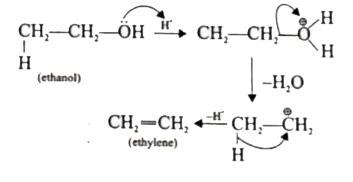(i) Explain-eletromeric effect.
(ii) Give the example forβ-elimination.
Text Solution
(i) Electromeric effect.
1. The electromic eggect refers to the polarity produced in a multiple bonded compound when it is attacked by a reagent when a double or triple bond is exposed to an attack by an electrophile the two π electrons which from the π bond are completely transferred to one atom or the other.
2. When a nucleophile approaches the carbonyl compound, the π-electrons. between C and O is instantaneously shifed to the more wlwctrobegative oxygen, This make the carbon electron deficient and hus facilitating the formation of a new bond between the incoming nucleophile and the corbonyl carbon atom .
.
3. Wgen an electrophile such as H+ approacges an alkene molecule the π electron are instantaneously shifted to the electrophilr and a new bond is formed between carbon and hydrogen, This makes the other carbon electron deficient and hence it acquires a positive charge 
4. This effect denotes as E-effect.
(ii) ~beta~-elimination: Elimination reactions ibvolve the cleavage of a σ bond and formation of a π bond. A nicleophilic pair of electrons heads into a new π bond as a leaving group departs. This process is called β-elmination because the bond β to the nuclwophilic pair of electrons breaks. Example:
1. n-propyl bromide on reaction with alcoholic KOH give propene. In this reaction hydrozen and Br are elimineted.

2. Acid-catalysed dehydration of alcohols  .
.
|
Topper's Solved these Questions
- SOLVED PAPER 03Book:FULL MARKSChapter:SOLVED PAPER 03Exercise:PART-III
Explore 9 Videos
- SOLUTIONS Book:FULL MARKSChapter:SOLUTIONS Exercise:ADDITIONAL QUESTIONS SOLVED - NUMERICAL PROBLEMS
Explore 15 Videos
- SOLVED PAPER 13 (UNSOLVED)Book:FULL MARKSChapter:SOLVED PAPER 13 (UNSOLVED)Exercise:PART-II
Explore 9 Videos
Similar Questions
Knowledge Check
Which of the following is a β-elimination reaction ?
A BCHCl3+KOHΔ−−→CCl2C
BCHCl3+KOHΔ−−→CCl2C D
D
Explain the following reactions with suitable examples.
Hofmann elimination reaction.
View SolutionWhat is β-elimination reaction ?
View SolutionExplain inhibitory effect of auxins with the help of one example
View SolutionWhat is tyndall effect ? Explain with an example.
View SolutionWhat is Tyndall effect? Explain with an example.
View SolutionGive an example of β -elimination reaction of alkyl halides.
View SolutionGive an example of β -elimination reaction of alkyl halides.
View Solution

